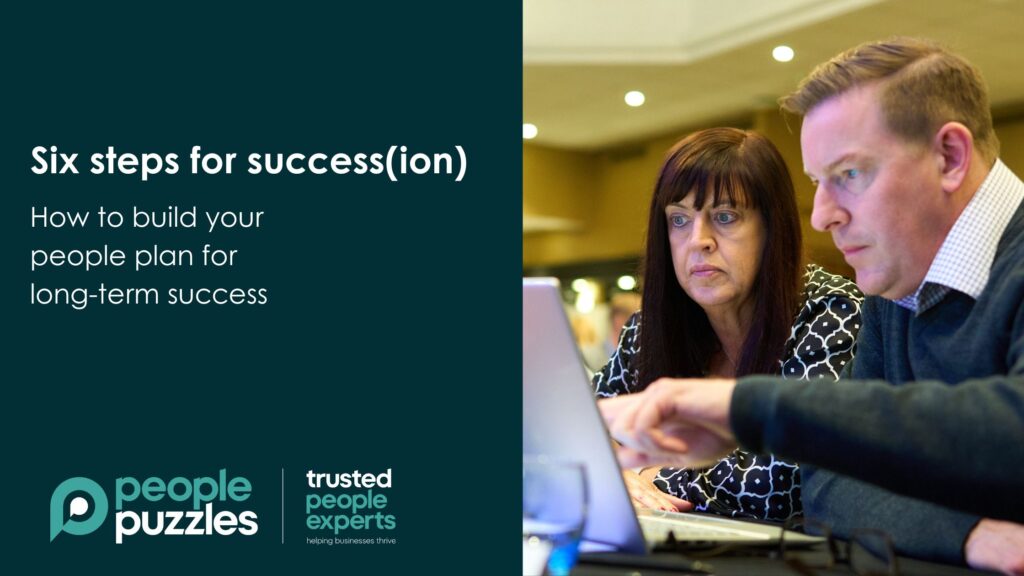6 steps for success(ion) – how succession planning can help ensure the long-term success of your business
Effective succession planning is a critical aspect of ensuring the long-term stability and growth capability of your business. It provides an essential framework for planning the development and progression of your people and builds foundations for the ongoing legacy of your business in the long term.
So, how do you approach succession planning? At its core, this is organisational design with a long-term outlook. It requires clarity of vision and direction, an accurate assessment of the talent and scope of the people in your business, and their individual ambition and drive for progression. These elements are mapped against the optimised organisational structure needed to help you achieve your objectives, creating the scope and competencies for growth. Whether you are a business owner looking to prepare for exit or a leader building the strategic people plan to support long term growth, succession planning is an important part of the process.
Why does Succession Planning matter for SMEs?
It’s all about providing a sustainable business future for years to come, providing opportunities for future generations and creating the roadmap for business owners to plan and control their own progression. Effective succession planning plays an important part in:
- Continuity and stability: Ensure a strong leadership pipeline to reduce disruption during transitions, to ensure successors are as prepared as possible before taking on a new role. It is a vital part of ensuring the longer-term sustainability of your business.
- Retention, engagement and motivation: Demonstrate your commitment to the professional development of your people to help them progress and keep them engaged and motivated. This also ensures that you are investing in the internal capability of your own business so it’s a real win: win.
- Knowledge transfer: Document and refine your processes across the business to ensure that critical knowledge and information is available for people in new roles, ensuring that this experience is not lost or reliant on a small number of individuals.
- Adapting to market changes: Keep up to date with emerging skills and competency requirements in a rapidly changing environment. Proactive succession planning helps you to identify existing skills gaps and opportunities for new developments, and lets you be more responsive to change.
- Talent attraction: Attract, motivate and retain the best people with a well-thought-out succession plan as part of your employer brand proposition. Long-term career progression opportunity is an attractive quality and as well as being confidence-inspiring from a commercial perspective, it also provides assurance that you will continue to invest in your people as you grow.
- Owner progression: Ensure your interests and progression as a business owner or leader are factored into the plan to ensure the future succession of leadership and intentional exit from the business at the right time.
Six steps to guide our succession planning
While every business is different, there are certain processes to follow when designing an effective succession plan. These processes will often include the following steps:
- Define your strategy, values and goals. It is essential to understand where your business is going, in order to create the right HR roadmap to support that evolution.
- Design the right organisational structure: Once you know your strategy and goals, you can design the right structure to fulfil those ambitions. Start by identifying the critical roles for where you want to be, and map these against where you are now to find the gaps and scope for growth.
- Assess and develop talent: Evaluate current employees and identify high-potential individuals who could step into key roles in time. It is important not to make assumptions here about how and when people want to progress. Make this a two-way conversation as people are more engaged and motivated by being consulted in this process and it helps to define and manage expectations. From here, you can start to create the right development and training plans across all levels of the business to help people build their competencies and prepare them for future progression.
- Create a documented Succession Plan: Ensure you capture the outputs of these processes as a formal succession plan, which will help you to clearly define criteria, both from technical and cultural perspectives, and will make it easier to monitor progress and success over time.
- Regularly review and update: Succession planning is not a one-off exercise. Regularly review and update your plan to ensure it remains relevant as your business evolves. This includes re-evaluating each step, including strategy and goals, to make sure your business is still heading in the right direction and has the right infrastructure to get you to your intended destination.
- Tap into the right expertise: From design and communication to delivery and evaluation, ensuring you have the right resource within your business to plan and execute an effective succession plan is key. Often it can help to introduce external resource to do this, as an impartial perspective can add significant value and facilitate complex and often challenging conversations and decision-making.
Succession planning is an essential framework to enable the long-term, sustainable growth of your business. By taking a strategic and people-focused approach, SMEs can build a robust leadership pipeline, foster talent attraction and retention, drive employee engagement, enrich the existing skills and capabilities within the business and adapt to changing market dynamics. There is no one-size-fits-all solution, so it is important to spend time on each step to make sure it’s right for your unique business.
If you would benefit from guidance and support in identifying the right succession planning processes for your business, please get in touch to arrange a complimentary consultation. You can call us on 0345 646 5201, email [email protected] or fill in our contact form on our website and we will get back to you to follow up.


